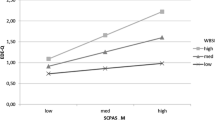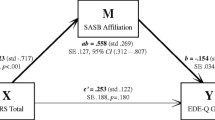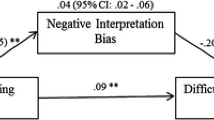Abstract
The current study tested the role of distress tolerance between cognitive schemas (emotional inhibition, defectiveness/shame, social isolation, and insufficient self-control) and eating disorder (ED) risk in a sample of 469 college students via structural equation analysis. While research indicates maladaptive cognitive schemas are positively associated with dysregulated eating, mechanisms of this relationship are not well established. Distress tolerance has been consistently associated with bulimia behaviors and body dissatisfaction; however, few studies have evaluated the role of distress tolerance in relation to cognitive schemas. In the current study, distress tolerance mediated associations between specific schemas of social isolation and insufficient self-control and eating disorder risk. These findings provide preliminary evidence suggesting specific cognitive schemas may contribute to low distress tolerance, which increases risk of ED-related behaviors and cognitions.

Similar content being viewed by others
References
Anestis, M. D., Selby, E. A., Fink, E. L., & Joiner, T. E. (2007). The multifaceted role of distress tolerance in dysregulated eating behaviors. International Journal of Eating Disorders, 40(8), 718–726. https://doi.org/10.1002/eat.20471.
Anestis, M. D., Smith, A. R., Fink, E. L., & Joiner, T. E. (2009). Dysregulated eating and distress: examining the specific role of negative urgency in a clinical sample. Cognitive Therapy and Research, 33(4), 390–397. https://doi.org/10.1007/s10608-008-9201-2.
Chapman, A. L., Gratz, K. L., & Brown, M. Z. (2006). Solving the puzzle of deliberate self harm: the experiential avoidance model. Behaviour Research & Therapy, 44(3), 371–394. https://doi.org/10.1016/j.brat.2005.03.005.
Claes, L., & Muehlenkamp, J. J. (2014). Non-suicidal self-injury in eating disorders: advancements in etiology and treatment. New York: Springer-Verlag Publishing.
Cooper, M. J. (2005). Cognitive theory in anorexia nervosa and bulimia nervosa: progress, development and future directions. Clinical Psychology Review, 25(4), 511–531.
Cooper, M. J., Cohen-Tovee, E., Todd, G., Wells, A., & Tovee, M. (1997). The eating disorder belief questionnaire: preliminary development. Behaviour Research and Therapy, 35, 381–388.
Cooper, M. J., Rose, K. S., & Turner, H. (2006). The specific content of core beliefs and schema in adolescent girls high and low in eating disorder symptoms. Eating Behaviors, 7(1), 27–35. https://doi.org/10.1016/j.eatbeh.2005.05.007.
Cooper, M., & Turner, H. (2000). Underlying assumptions and core beliefs in anorexia nervosa and dieting. British Journal of Clinical Psychology, 39, 215–218.
Corstorphine, E., Mountford, V., Tomlinson, S., Waller, G., & Meyer, C. (2007). Distress tolerance in the eating disorders. Eating Behaviors, 8(1), 91–97.
Culbert, K. M., Racine, S. E., & Klump, K. L. (2015). Research review: what we have learned about the causes of eating disorders - a synthesis of sociocultural, psychological, and biological research. Journal of Child Psychology & Psychiatry, 56(11), 1141–1164. https://doi.org/10.1111/jcpp.12441.
Cumella, E. J. (2006). Review of the eating disorder inventory–3. Journal of Personality Assessment, 87(1), 116–117. https://doi.org/10.1207/s15327752jpa8701_11.
Cyranowski, J. M., & Andersen, B. L. (1998). Schemas, sexuality, and romantic attachment. Journal of Personality & Social Psychology, 74(5), 1364–1379.
Davis, K. R., & Fischer, S. (2013). The influence of trait anger, trait anxiety and negative urgency on disordered eating. Personality & Individual Differences, 54(2), 307–310. https://doi.org/10.1016/j.paid.2012.08.036.
Eisenberg, D., Nicklett, E. J., Roeder, K., & Kirz, N. E. (2011). Eating disorder symptoms among college students: prevalence, persistence, correlates, and treatment-seeking. Journal of American College Health, 59(8), 700–707 708p. https://doi.org/10.1080/07448481.2010.546461.
Fischer, S., Smith, G. T., & Cyders, M. A. (2008). Another look at impulsivity: a meta-analytic review comparing specific dispositions to rash action in their relationship to bulimic symptoms. Clinical Psychology Review, 28(8), 1413–1425. https://doi.org/10.1016/j.cpr.2008.09.001.
Forney, K. J., & Ward, R. M. (2013). Examining the moderating role of social norms between body dissatisfaction and disordered eating in college students. Eating Behaviors, 14(1), 73–78. https://doi.org/10.1016/j.eatbeh.2012.10.017.
Gaher, R. M., Hofman, N. L., Simons, J. S., & Hunsaker, R. (2013). Emotion regulation deficits as mediators between trauma exposure and borderline symptoms. Cognitive Therapy and Research, 37(3), 466–475. https://doi.org/10.1007/s10608-012-9515-y.
Garner, D. M. (2004). EDI-3 Eating disorder inventory-3. Lutz: Psychological Assessment Resources, Inc..
Gentile, K., Raghavan, C., Rajah, V., & Gates, K. (2007). It doesn’t happen here: eating disorders in an ethnically diverse sample of economically disadvantaged, urban college students. Eating Disorders, 15(5), 405–425. https://doi.org/10.1080/10640260701667904.
Hinrichsen, H., Morrison, T., Waller, G., & Schmidt, U. (2007). Triggers of self-induced vomiting in bulimic disorders: the roles of core beliefs and imagery. Journal of Cognitive Psychotherapy, 21(3), 261–272.
Hovrud, L., & De Young, K. P. (2015). Unique contributions of individual eating disorder symptoms to eating disorder-related impairment. Eating Behaviors, 18, 103–106.
Hu, L., & Bentler, P. M. (1999). Cutoff criteria for fit indexes in covariance structure analysis: Conventional criteria versus new alternatives. Structural Equation Modeling, 6, 1–55.
Hughes, M. L., Hamill, M., van Gerko, K., Lockwood, R., & Waller, G. (2006). The relationship between different levels of cognition and behavioural symptoms in the eating disorders. Eating Behaviors, 7(2), 125–133.
Jenkins, P. E., Hoste, R. R., Meyer, C., & Blissett, J. M. (2011). Eating disorders and quality of life: a review of the literature. Clinical Psychology Review, 31(1), 113–121. https://doi.org/10.1016/j.cpr.2010.08.003.
Jenkins, P. E., Rienecke, R. D., Conley, C. S., Meyer, C., & Blissett, J. M. (2015). The relation between eating disorder symptoms and impairment. Journal of Nervous & Mental Disease, 203(6), 452–458. https://doi.org/10.1097/NMD.0000000000000301.
Keith, L., Gillanders, D., & Simpson, S. (2009). An exploration of the main sources of shame in an eating-disordered population. Clinical Psychology & Psychotherapy, 16(4), 317–327.
Kelly, N. R., Cotter, E. W., & Mazzeo, S. E. (2014). Examining the role of distress tolerance and negative urgency in binge eating behavior among women. Eating Behaviors, 15(3), 483–489. https://doi.org/10.1016/j.eatbeh.2014.06.012.
Lampard, A. M., Byrne, S. M., McLean, N., & Fursland, A. (2011). Avoidance of affect in the eating disorders. Eating Behaviors, 12(1), 90–93. https://doi.org/10.1016/j.eatbeh.2010.11.004.
Lavender, J. M., Happel, K., Anestis, M. D., Tull, M. T., & Gratz, K. L. (2015). The interactive role of distress tolerance and eating expectancies in bulimic symptoms among substance abusers. Eating Behaviors, 16, 88–91.
Leung, N., Waller, G., & Thomas, G. (1999). Core beliefs in anorexic and bulimic women. Journal of Nervous and Mental Disease, 187(12), 736–741. https://doi.org/10.1097/00005053-199912000-00005.
Leung, N., & Price, E. (2007). Core beliefs in dieters and eating disordered women. Eating Behaviors, 8(1), 65–72.
Luck, A., Waller, G., Meyer, C., Ussher, M., & Lacey, H. (2005). The role of schema processes in the eating disorders. Cognitive Therapy & Research, 29(6), 717–732. https://doi.org/10.1007/s10608-005-9635-8.
MacLaren, V. V., & Best, L. A. (2009). Female students' disordered eating and the big five personality facets. Eating Behaviors, 10(3), 192–195. https://doi.org/10.1016/j.eatbeh.2009.04.001.
Mason, T. B., Heron, K. E., Braitman, A. L., & Lewis, R. J. (2016). A daily diary study of perceived social isolation, dietary restraint, and negative affect in binge eating. Appetite, 97, 94–100. https://doi.org/10.1016/j.appet.2015.11.027.
Mikheeva, O. V., & Tragesser, S. L. (2016). Personality features, disordered eating, and alcohol use among college students: a latent profile analysis. Personality & Individual Differences, 94, 360–365. https://doi.org/10.1016/j.paid.2016.02.004.
Muthén, L. K., & Muthén, B. O. (2013). Mplus: Statistical Analysis with Latent Variables: User’s Guide (Version 7). Los Angeles, CA: Muthén & Muthén.
Racine, S. E., Keel, P. K., Burt, S. A., Sisk, C. L., Neale, M., Boker, S., & Klump, K. L. (2013). exploring the relationship between negative urgency and dysregulated eating: etiologic associations and the role of negative affect. Journal of Abnormal Psychology, 122(2), 433–444. https://doi.org/10.1037/a0031250.
Rijkeboer, M. M., & van den Bergh, H. (2006). Multiple group confirmatory factor analysis of the young schema-questionnaire in a Dutch clinical versus non-clinical population. Cognitive Therapy & Research, 30(3), 263–278.
Rijkeboer, M. M., Van den Bergh, H., & Van den Bout, J. (2011). Item bias analysis of the young schema-questionnaire for psychopathology, gender, and educational level. European Journal of Psychological Assessment, 27(1), 65.
Roper, L., Dickson, J. M., Tinwell, C., Booth, P. G., & McGuire, J. (2010). Maladaptive cognitive schemas in alcohol dependence: changes associated with a brief residential abstinence program. Cognitive Therapy and Research, 34(3), 207–215.
Sheeran, P., & Orbell, S. (2000). Self-schemas and the theory of planned behaviour. European Journal of Social Psychology, 30(4), 533–550.
Simons, J. S., & Gaher, R. M. (2005). The Distress Tolerance Scale: Development and validation of a self-report measure. Motivation and Emotion, 29(2), 83–102. https://doi.org/10.1007/s11031-005-7955-3.
StataCorp. (2015). Stata statistical software: release 14. College Station: StataCorp LP.
Stein, K. F. (1996). The self-schema model: a theoretical approach to the self-concept in eating disorders. Archives of Psychiatric Nursing, 10(2), 96–109.
Stein, K. F., & Corte, C. (2008). The identity impairment model: a longitudinal study of self schemas as predictors of disordered eating behaviors. Nursing Research, 57(3), 182–190. https://doi.org/10.1097/01.NNR.0000319494.21628.08.
Stein, K. F., & Corte, C. (2007). Identity impairment and the eating disorders: content and organization of the self-concept in women with anorexia nervosa and bulimia nervosa. European Eating Disorders Review, 15(1), 58–69.
Stice, E. (2002). Risk and maintenance factors for eating pathology: a meta-analytic review. Psychological Bulletin, 128(5), 825–848. https://doi.org/10.1037/0033-2909.128.5.825.
Striegel-Moore, R. H., Seeley, J. R., & Lewinsohn, P. M. (2003). Psychosocial adjustment in young adulthood of women who experienced an eating disorder during adolescence. Journal of the American Academy of Child & Adolescent Psychiatry, 42(5), 587.
Tabachnick, B. G., & Fidell, L. S. (2007). Using multivariate statistics (5th ed.). Boston: Allyn & Bacon/Pearson Education.
Turner, H., & Cooper, M. (2002). Cognitions and their origins in women with anorexia nervosa, normal dieters and female controls. Clinical Psychology & Psychotherapy, 9(4), 242–252. https://doi.org/10.1002/cpp.317.
Vansteelandt, K., Claes, L., Muehlenkamp, J., De Cuyper, K., Lemmens, J., Probst, M., & Pieters, G. (2013). Variability in affective activation predicts non-suicidal self-injury in eating disorders. European Eating Disorders Review, 21(2), 143–147. https://doi.org/10.1002/erv.2220.
Waller, G., Corstorphine, E., & Mountford, V. (2007). The role of emotional abuse in the eating disorders: implications for treatment. Eating Disorders, 15(4), 317–331. https://doi.org/10.1080/10640260701454337.
Waller, G., Ohanian, V., Meyer, C., & Osman, S. (2000). Cognitive content among bulimic women: the role of core beliefs. The International Journal of Eating Disorders, 28(2), 235–241.
Westen, D., & Heim, K. (2003). Disturbances of the self and identity in personality disorders. In M. Leary & J. Tangney (Eds.), Handbook of Self and Identity (pp. 643–664). New York: Guilford Press.
Wray, T. B., Simons, J. S., Dvorak, R. D., & Gaher, R. M. (2012). Trait-based affective processes in alcohol-involved ‘risk behaviors’. Addictive Behaviors, 37(11), 1230–1239. https://doi.org/10.1016/j.addbeh.2012.06.004.
Young, J. E. (1998). The Young schema questionnaire: short form.
Young, J. (2005a). Young schema questionnaire—short form. New York: Schema Therapy Institute.
Young, J. E. (2005b). Young Schema Questionnaire—Short Form 3 (YSQ-S3). New York: Cognitive Therapy Center.
Funding
This study was funded by The University Research Fellowship and the Department of Psychology.
Author information
Authors and Affiliations
Corresponding author
Ethics declarations
Conflict of Interest
Authors Lindsey Hovrud, Raluca Simons, and Jeffrey Simons declare they have no conflict of interest.
Ethical Approval
All procedures performed in studies involving human participants were in accordance with the ethical standards of the institutional and/or national research committee and with the 1964 Helsinki declaration and its later amendments or comparable ethical standards. This article does not contain any studies with animals performed by any of the authors
Informed Consent
Informed consent was obtained from all individual participants included in the study.
Disclaimer
None of the funding sources had a role in the study design, collection, analysis or interpretation of the data, writing the manuscript, or the decision to submit the paper for publication.
Additional information
Publisher’s Note
Springer Nature remains neutral with regard to jurisdictional claims in published maps and institutional affiliations.
Rights and permissions
About this article
Cite this article
Hovrud, L., Simons, R. & Simons, J. Cognitive Schemas and Eating Disorder Risk: the Role of Distress Tolerance. J Cogn Ther 13, 54–66 (2020). https://doi.org/10.1007/s41811-019-00055-5
Published:
Issue Date:
DOI: https://doi.org/10.1007/s41811-019-00055-5




